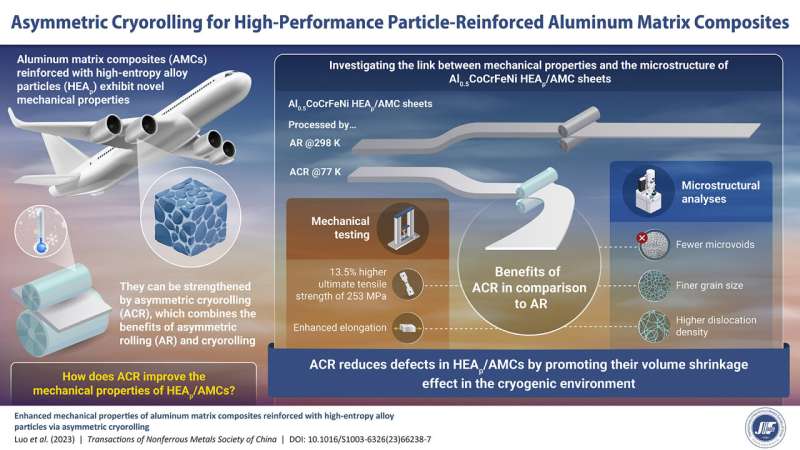This article has been reviewed according to Science X's editorial process and policies. Editors have highlighted the following attributes while ensuring the content's credibility:
fact-checked
proofread
Researchers create high-performance aluminum matrix composites with asymmetric cryocooling

Our ongoing endeavor to venture into outer space demands substantial technological advances across various fields, including materials science. Materials used in the aerospace industry must be lightweight yet mechanically resistant, a combination that is difficult to achieve. Fortunately, metal matrix composites have come a long way since their inception in the twentieth century, and many experts believe that they will be key to near-future space applications.
One of the most promising types of metal matrix composites are aluminum matrix composites (AMCs) reinforced with high-entropy alloy particles (HEAps), which can endow AMCs with superior mechanical properties, including high strength, durability, and plasticity. However, HEAps also generate structural defects, such as microcracks and microvoids, which can be problematic.
Against this backdrop, a research team led by Professor Hai-liang Yu from Central South University, China, is investigating a new way to manufacture high-performance HEAp/AMC flat sheets.
In their latest study, published in Transactions of Nonferrous Metals Society of China, the team explored a promising technique called asymmetric cryorolling (ACR), which combines the advantages of cryorolling and asymmetric rolling (AR).
AR is a well-established technique in steel manufacturing that involves passing a metal plate through a rolling mill. This process applies a large shear strain uniformly through the thickness of the plate, which helps reduce the number of defects. The only practical difference between AR and ACR is their operating temperature. While AR is carried out at room temperature, ACR is conducted at cryogenic temperatures achieved using liquid nitrogen.
Some previous studies have shown that ACR can improve the mechanical properties of HEAp/AMC sheets. But the corresponding strengthening mechanism and the link between mechanical properties and microstructure of AMCs during ACR remains unclear. To address this knowledge gap, the researchers prepared HEAp/AMC sheets using AR at 298 K and ACR at 77 K and analyzed them using scanning and transmission electron microscopy techniques along with tensile and hardness tests.
They found important microstructural differences between the sheets prepared via AR and ACR. Cryogenic processing produced sheets with fewer microvoids, finer grain size, and a higher density of dislocations. Moreover, the mechanical tests revealed that ACR sheets were significantly more ductile and stronger than AR sheets. "The ultimate tensile strength of 3 wt% HEAp/AMCs prepared via ACR reached 253 MPa, 13.5% higher than that achieved by sheets prepared via AR," highlights Prof. Yu.
The researchers concluded that the observed differences between ACR and AR were mainly due to the volume shrinkage effect of HEAp/AMCs.
"The larger the volume shrinkage effect of the aluminum alloy, the more tightly the aluminum will wrap around the reinforcing HEAps. This strengthens the bonding between the matrix and the particles," explains Prof. Yu. "Since the volume shrinkage effect is larger in cryogenic environments, ACR plays a significant role in preventing defects caused by the large plastic deformation of HEAp/AMC sheets."
Overall, these findings suggest that ACR could play a key role in developing new alloys for aerospace and automotive industries, and may even become the go-to technology for high-performance materials in the future.
More information: Kai-guang Luo et al, Enhanced mechanical properties of aluminum matrix composites reinforced with high-entropy alloy particles via asymmetric cryorolling, Transactions of Nonferrous Metals Society of China (2023). DOI: 10.1016/S1003-6326(23)66238-7
Provided by Cactus Communications





















